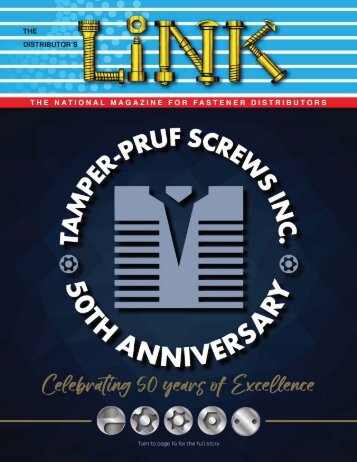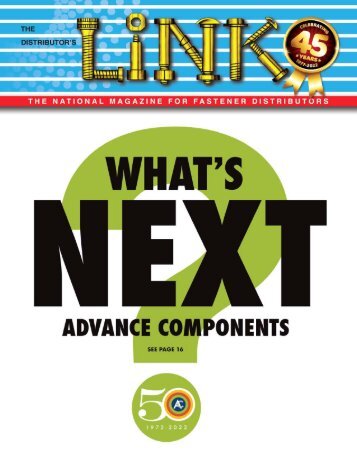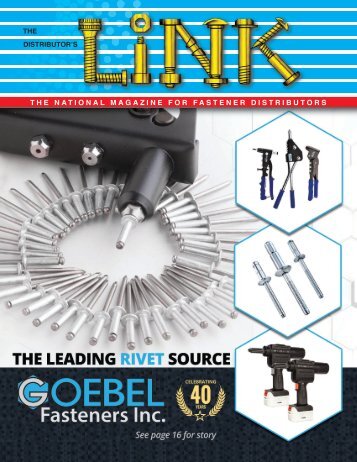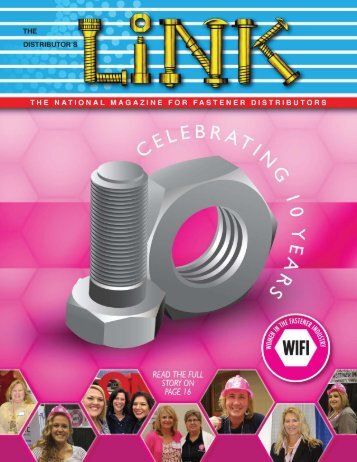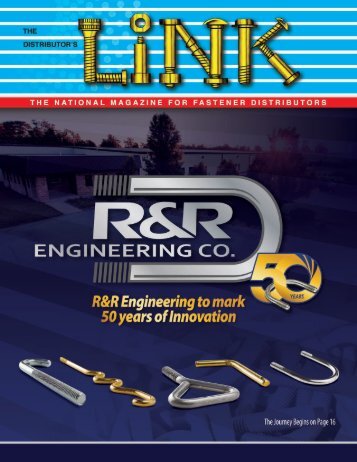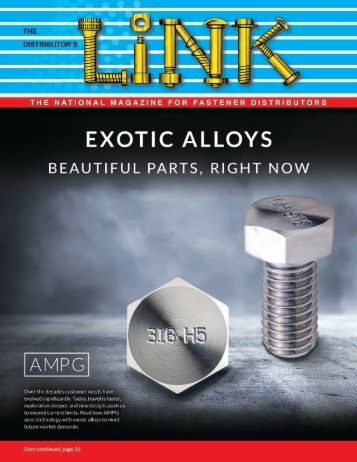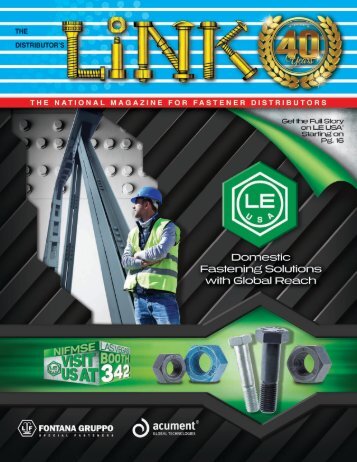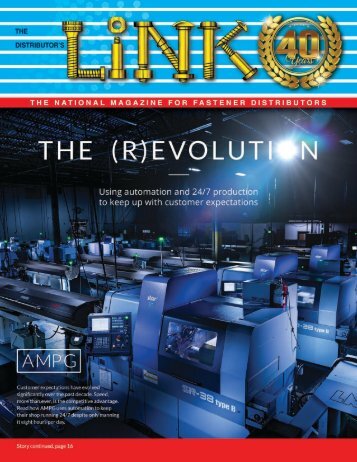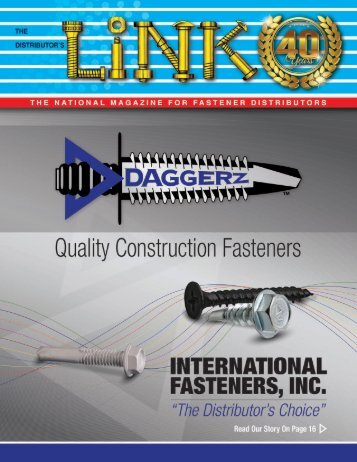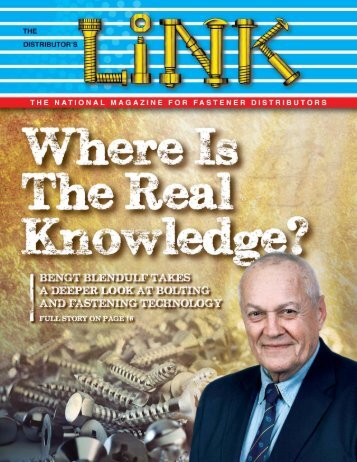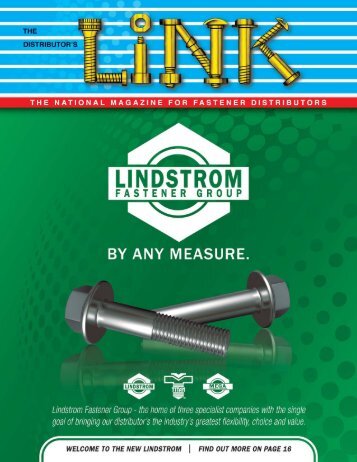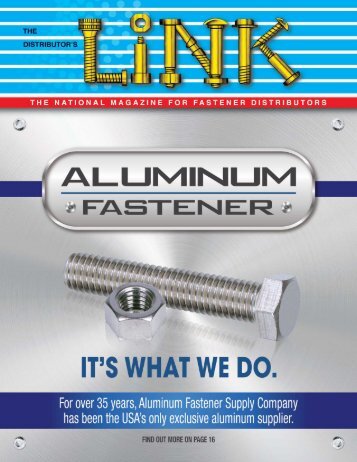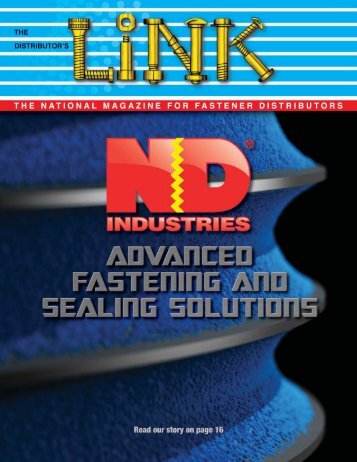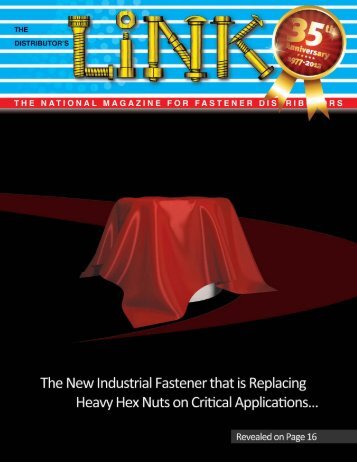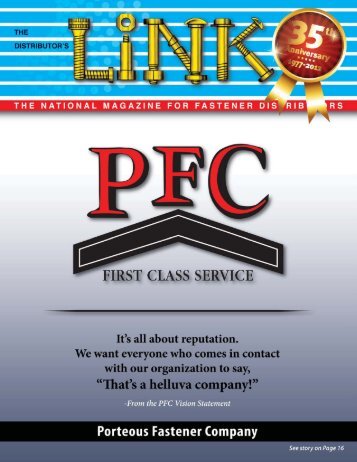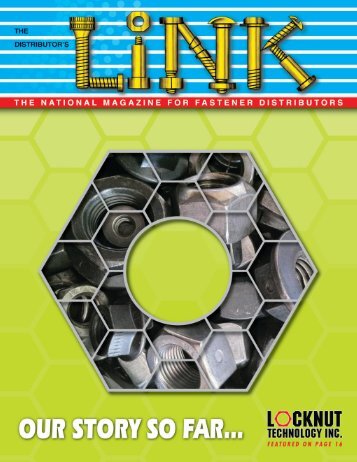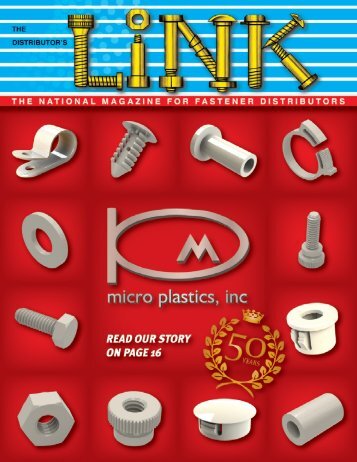FALL 2021
- Text
- Wwwgraphikacreativecom
- Bolts
- Screws
- Pins
- Joints
- Products
- Distributors
- Magnetic
- Continued
- Fasteners
- Fastener
100 THE DISTRIBUTOR’S
100 THE DISTRIBUTOR’S LINK ROB LaPOINTE MAGNETIC PARTICLE TESTING VS. PENETRANT TESTING – WHICH TEST IS BEST? from page 8 FIGURE 3 - A CUTAWAY SECTION OF A FULLY THREADED STUD SHOWING A VOID OF MATERIAL KNOW AS A BURST ASTM F788, Standard Specification for Surface Discontinuities of Bolts, Screws, Studs, and Rivets, Inch and Metric Series, provides us with a list of and examples of surface discontinuities common to fasteners. F788 also provides tolerances for allowable discontinuities. Discontinuities that are not open to the surface such as internal voids, internal bursts, or inclusions are not able to be detected by PT and many are not detectable by MT. Magnetic particle testing does offer the ability to detect subsurface discontinuities provided they are close to the surface and the technician is skilled at spotting them. Figure 3 shows a subsurface discontinuity that would not be detectable by penetrant or magnetic particle testing. The burst in Figure 2 is not connected to the surface and is too deep below the surface for the possibility of detection by MT. For discontinuities like these, other NDT methods like ultrasonic or radiograph testing would be useful. These methods can image the inside of something without cutting it open. They are essentially the same as the medical techniques used to image unborn babies (ultrasound) or a broken leg (x-ray). It would also be worth our time to understand a little more about nondestructive testing. Nondestructive testing is just that – nondestructive. This testing does not destroy, mark, or otherwise injure the part to collect data. Specifically, nondestructive testing accesses the quality of the material and workmanship of the product to ensure that there are no hidden flaws that would render the part unfit for service. Also, since it’s nondestructive, test parts can be sold and used along with the production lot after testing. For highly controlled products, it is common for 100 % of the production lot to be tested for flaws using a nondestructive method. Nondestructive testing includes many detection methods such as Magnetic Particle Testing (MT), Penetrant Testing (PT), Visual Testing (VT), Ultrasonic Testing (UT), Radiographic Testing (RT) and many others. Personnel training, qualification and certification is typically an employer-based system through guidelines provided by the American Society for Nondestructive Testing (ASNT) using the SNT-TC-1A standard and the National Aerospace Standard NAS 410. It is a highly technical and regulated branch of materials testing. FIGURE 4 - THE RIGHT-HAND RULE FOR LOCATING THE MAGNETIC FIELD RELATING TO AN ELECTRICAL CURRENT Magnetic particle testing makes use of magnetic fields created by the flow of charges to detect breaks or discontinuities in conductive and magnetizable materials. To understand how this works, we need to be acquainted with some physics of electromagnetism. Don’t worry, we won’t be deriving Maxwell’s equations here, just some basic spatial relationships between electrical current and magnetic fields. When electrical current (electrons) flows through a metal, a magnetic field is created which incircles the flow. Physics students around the world use what’s called the “Right-hand Rule” for understanding this relationship. Figure 4 shows the right-hand rule. Notice that if your right thumb points in the direction of the current, then your curled fingers point in the direction of the magnetic field created by the flow. CONTINUED ON PAGE 158
THE DISTRIBUTOR’S LINK 101
- Page 6 and 7:
in the Fall 2021 issue of 6 DISTRIB
- Page 8:
6 THE DISTRIBUTOR’S LINK Pivot Po
- Page 12:
10 THE DISTRIBUTOR’S LINK Bruno M
- Page 16:
14 THE DISTRIBUTOR’S LINK SPECIAL
- Page 28:
26 THE DISTRIBUTOR’S LINK Guy Ave
- Page 32:
30 THE DISTRIBUTOR’S LINK Larry B
- Page 36 and 37:
34 THE DISTRIBUTOR’S LINK Joe Dys
- Page 38:
36 THE DISTRIBUTOR’S LINK Laurenc
- Page 41 and 42:
All Integrated Solutions (AIS), a d
- Page 46:
44 THE DISTRIBUTOR’S LINK ALL-PRO
- Page 50 and 51:
48 THE DISTRIBUTOR’S LINK Robert
- Page 52 and 53: 50 THE DISTRIBUTOR’S LINK MID-WES
- Page 54 and 55: 52 THE DISTRIBUTOR’S LINK Roman B
- Page 56: 54 THE DISTRIBUTOR’S LINK Nelson
- Page 59 and 60: THE DISTRIBUTOR’S LINK 57 ...cont
- Page 61 and 62: THE DISTRIBUTOR’S LINK 59
- Page 63 and 64: THE DISTRIBUTOR’S LINK 61 OPEN HO
- Page 65 and 66: THE DISTRIBUTOR’S LINK 63
- Page 68 and 69: 66 THE DISTRIBUTOR’S LINK SPIROL
- Page 70: 68 THE DISTRIBUTOR’S LINK BATCHIN
- Page 74 and 75: 72 THE DISTRIBUTOR’S LINK Len LaP
- Page 76: 74 THE DISTRIBUTOR’S LINK 2152 Ma
- Page 79 and 80: NCFA 12th ANNUAL DISTRIBUTOR SOCIAL
- Page 81 and 82: PROSPECT FASTENER THE DISTRIBUTOR
- Page 84 and 85: 82 THE DISTRIBUTOR’S LINK INTERCO
- Page 86: MID-WEST FASTENER ASSOCIATION TABLE
- Page 90: 88 THE DISTRIBUTOR’S LINK GLOBALF
- Page 94 and 95: 92 THE DISTRIBUTOR’S LINK PACIFIC
- Page 96: 94 THE DISTRIBUTOR’S LINK At its
- Page 101: THE DISTRIBUTOR’S LINK 99
- Page 106 and 107: 104 THE DISTRIBUTOR’S LINK CHRIS
- Page 108 and 109: 106 THE DISTRIBUTOR’S LINK STAFDA
- Page 110 and 111: 108 THE DISTRIBUTOR’S LINK DAN WA
- Page 112: 110 THE DISTRIBUTOR’S LINK GUY AV
- Page 116: 114 THE DISTRIBUTOR’S LINK COMPUT
- Page 119 and 120: THE DISTRIBUTOR’S LINK 117
- Page 121 and 122: THE DISTRIBUTOR’S LINK 119 Semble
- Page 124: 122 THE DISTRIBUTOR’S LINK ICS FL
- Page 128 and 129: 126 THE DISTRIBUTOR’S LINK JIM TR
- Page 130 and 131: 128 THE DISTRIBUTOR’S LINK MWFA F
- Page 132 and 133: 130 THE DISTRIBUTOR’S LINK ROBERT
- Page 136 and 137: MID-WEST FASTENER ASSOCIATION TABLE
- Page 138 and 139: 136 THE DISTRIBUTOR’S LINK NELSON
- Page 140 and 141: 138 THE DISTRIBUTOR’S LINK ENGINE
- Page 142: 140 THE DISTRIBUTOR’S LINK ANTHON
- Page 145 and 146: MID-WEST FASTENER ASSOCIATION MIXER
- Page 147 and 148: THE DISTRIBUTOR’S LINK 145
- Page 149 and 150: MID-WEST FASTENER ASSOCIATION 75th
- Page 151 and 152: THE DISTRIBUTOR’S LINK 149 GLOBAL
- Page 153 and 154:
Goebel Fasteners, Inc. announced re
- Page 155 and 156:
fastenerlinks BRINGING YOU THE FAST
- Page 157 and 158:
fastenerlinks BRINGING YOU THE FAST
- Page 160 and 161:
158 THE DISTRIBUTOR’S LINK ROB La
- Page 162 and 163:
160 THE DISTRIBUTOR’S LINK BRUNO
- Page 164:
162 THE DISTRIBUTOR’S LINK FASTEN
- Page 167 and 168:
THE DISTRIBUTOR’S LINK 165 NATION
- Page 169 and 170:
MID-WEST FASTENER ASSOCIATION 68th
- Page 171 and 172:
THE DISTRIBUTOR’S LINK 169
- Page 173 and 174:
THE DISTRIBUTOR’S LINK 171
- Page 175 and 176:
THE DISTRIBUTOR’S LINK 173 MID-WE
- Page 178 and 179:
176 THE DISTRIBUTOR’S LINK LAUREN
- Page 180 and 181:
178 THE DISTRIBUTOR’S LINK ALL-PR
- Page 182 and 183:
180 THE DISTRIBUTOR’S LINK ROB La
- Page 184 and 185:
182 THE DISTRIBUTOR’S LINK ALL-PR
- Page 186:
MID-WEST FASTENER ASSOCIATION 75th
- Page 190:
advertisers index C COMPUTER INSIGH
- Page 194:
advertisers index P PROSPECT FASTEN
Inappropriate
Loading...
Mail this publication
Loading...
Embed
Loading...
|
SHARE A PAGE FROM THIS MAGAZINE OPTION 1: Click on the share tab above, or OPTION 2: Click on the icon (far right of toolbar) and then click on the icon (far right of toolbar) and then click on the  icon (top right of the page). icon (top right of the page).
|
View Archives
Copyright © Distributor's Link, Inc. All Rights Reserved | Privacy Policy







